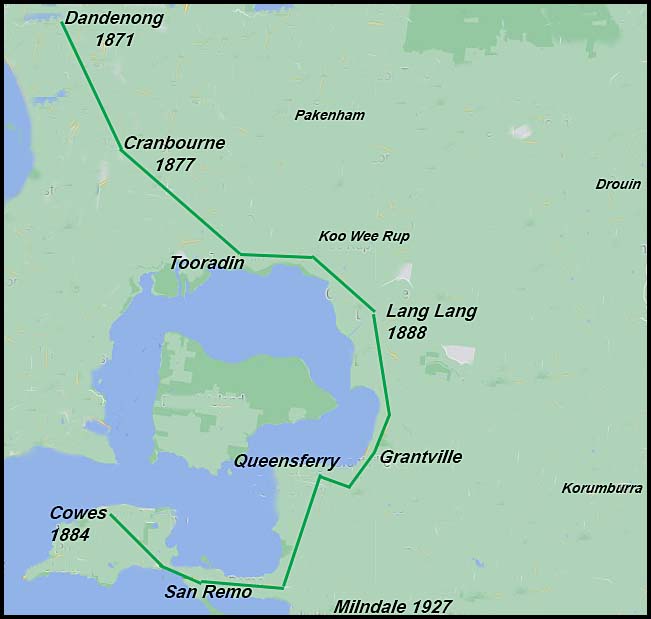The Cowes (Westernport) line.
- Australia 1901-1988
- New South Wales
- Queensland
- South Australia
- Tasmania
- Victoria
- Western Australia
- International
- Special aspects
 |
There were several reasons as to why the area to Cowes should be opened to telegraphic communication. These include:
|
In 1876, a line was extended south-east from Dandenong to Cranbourne.
On 4 May 1883, The Argus reported on:
"A deputation, consisting of members of the shire council and residents of Phillip Island visiting town yesterday with the view of interviewing Mr Landridge, who is acting at present as Postmaster General in the absence of Mr Berry at Sydney. Finding that Mr. Landridge was also out of Melbourne yesterday, they waited instead on Mr McGowan, acting Deputy Postmaster General, to whom they were introduced by Mr Gibb M L A. The object of their visit was to ask for telegraphic communication either by means of an extension from Frankston to Sandy Point and thence by a submarine cable to Cowes, or by means of an extension from Cranbourne through Tooradin, Grantville, Queensferry, Bass and Kilcunda to Griffith's Point and thence by a wire crossing the eastern entrance to Western Point and the island itself to Cowes. Mr Lalor, the Speaker of the Assembly had on the previous day urged the desirability of extending the Cranbourne line to Kilcunda, on the ground that important work was now being carried on in connection with the coal mines at the latter place. Mr McGowan desired the applicants to arrange for another deputation after Mr. Berry's return from Sydney".
On 19 May 1883, The Argus reported on the follow-up meeting:
"A large deputation of residents of and persons interested in Phillip Island was introduced to the Postmaster General yesterday by Mr. Gibb, M.L.A.. They asked that telegraphic communication might be established to Cowes. Two routes were suggested - one by wire from Frankston to Hastings and thence by cable to Cowes; the other by wire from Cranbourne to Griffiths Point, thence by cable to the island and on by wire to Cowes. Mr Berry promised to make inquiries and to obtain reports as to both routes and as to the amount of revenue which would be yielded. The residents would probably be asked to guarantee the department against any loss".
On 31 October 1983, the South Bourke and Mornington Journal reported a supportive move from the Cranbourne Shire Council "stating that their President had been deputed to act in conjunction with this Council in ary action taken with a view of having the electric telegraph to Phillip Island via Canbourne, Yallock, and Bass".
The Daily Telegraph of 31 October 1884 observed that :"in reference to the extension of the telegraph to Phillip Island, the Postmaster-General and the Deputy Postmaster-General leave today (Friday) for the purpose of inspecting the telegraph extension to Cowes on Phillip Island. This extension goes via Dandenong, Cranbourne, Grantville, Queensferry and Griffith's Point on to the Cowes township. The principal feature of this extension is the suspension of the wires over the west channel which separates Phillip Island from the mainland. The wires are suspended from up rights on either side 100 feet in height and the span is 650 yards. (It will be understood by residents that it is not the West Channel but the "Eastern Passage" that is meant)".
The Shire of Phillip Island on 3 January 1885 received a communication from the Post and Telegraph Department, stating that the contractor had been requested to remove the fallen timber and obstructions which had been felled by him in the clearing of the telegraph line. The Secretary was instructed to write stating that the Council would now withdraw all objections to the manner in which the road had been cleared as the contractor had removed such of the fallen timber as was dangerous.
The Mornington Journal of 30 September 1885 reported as follows:
"As regards telegraph communication, the question of that between Melbourne and Cowes has been the most important line erected for many years.
The line has been continued from Cranbourne via Tooradin, Grantville, Bass and Griffith's Point, thence across the Eastern Passage to Cowes.
The wire has been suspended across the sea between the shores of Grifith's Point and Newhaven from two masts comprising each a lower and top mast at a total height from the ground of at least 160 feet, the span between the two top masts being about 620 yards.
As these masts were both erected on sandy soil, some doubt at first existed that they would stand the strain of the wire and the boisterous weather they were expected to encounter. Events have proved that they are tight, staunch and strong and that the work was done well and faithfully by the contractor, Mr. T. Irving, under the superintendence of Mr. Deering in the Post Office Department".
Unfortunately, the worst of results from that endevour: "The ketch Truganini has just broken the telegraph wire which spans the eastern passage between San Pedro and Newhaven thereby stopping all communication with Phillip Island by wire"(The Argus 27 March 1889).
In October 1901, it was reported that "the work of replacing defective telegraph poles on the line from Lang Lang to San Remo and Cowes is preceding - the timber required being obtained from Mr. Coles' property".
The 1890 classifications.
As an example of the way Telegraph Offices changed classification of particular lines:
- in 1880, Cranbourne was on a 9 mile branch of its own coming from Dandenong.
- in 1884, the 53 mile Westernport Line (as it was then called) had been redefined to include the Telegraph Offices at Dandenong, Cranbourne, Tooradin, Grantville, Griffith's Point and Cowes.
| Line 32: | Melbourne through Instrument Room, Malvern Test Box, Dandenong, Cranbourne, Tooradin, Lang Lang, Grantville, Queensferry, Bass (telephone), San Remo to Cowes. |